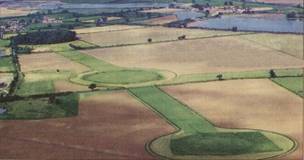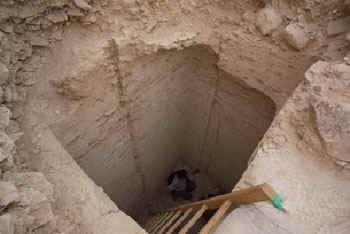 In December last year
(Newsletter 89), I
reported on Tarmac’s request for a deferment of a planning application to extend
quarrying operations, in an area close to the Thornborough Henges in North Yorkshire. The
delay was to allow an independent survey to be carried out to assess the archaeological
importance of the surrounding area. The resulting report, funded by Tarmac, concluded that
archaeological remains in these areas were not of national significance. However English
Heritage has vigorously refuted these claims and I can now report that the application has
been turned down. The North Yorkshire Council voted 6 to 3 against, concluding that the
application went against North Yorkshire’s mineral local plan; the location and scale
of the quarrying would have an adverse impact on “nationally important archaeological
remains.” An English Heritage spokesperson said: “We are pleased that this
application has been refused as we believe that nationally important archaeology would
have been destroyed by the extension”. In December last year
(Newsletter 89), I
reported on Tarmac’s request for a deferment of a planning application to extend
quarrying operations, in an area close to the Thornborough Henges in North Yorkshire. The
delay was to allow an independent survey to be carried out to assess the archaeological
importance of the surrounding area. The resulting report, funded by Tarmac, concluded that
archaeological remains in these areas were not of national significance. However English
Heritage has vigorously refuted these claims and I can now report that the application has
been turned down. The North Yorkshire Council voted 6 to 3 against, concluding that the
application went against North Yorkshire’s mineral local plan; the location and scale
of the quarrying would have an adverse impact on “nationally important archaeological
remains.” An English Heritage spokesperson said: “We are pleased that this
application has been refused as we believe that nationally important archaeology would
have been destroyed by the extension”.
Tarmac are disappointed by the decision and are set to appeal against it, as they maintain
the application is both justified and reasonable. They are insisting that English
Heritage’s view of the archaeology importance of the site is not supported by factual
evidence. The decision, however, will come as a great relief to all those involved in the
campaign, - and will be seen as a major step forward in halting all quarrying in this
unique archaeological landscape.
New Tomb in the Valley of the Kings
Archaeologists have discovered the first intact tomb in the Valley of the Kings since
King Tutankhamun's was found in 1922. It is the 63rd tomb to be discovered since the
valley was first mapped in the 18th century, and was unexpectedly found only five metres
away from the boy-king’s resting place. The team, from the University of Memphis,
were focused on the tomb of a 19th Dynasty pharaoh, King Amenmesses looking for foundation
deposits. Working in front of the tomb they were clearing away some workmen's huts from
the 19th Dynasty when a shaft appeared.
After clearing the shaft to a depth of four metres, they came across a single chamber
containing sarcophagi, five mummies and more than 20 large storage jars bearing Pharaonic
seals. The sarcophagi, complete with coloured funerary masks, had been buried rapidly and
speculation is now rife as to who they could belong to. The tomb is thought to date from
the 18th Dynasty, the first dynasty of the New Kingdom, which ruled between 1539BC and
1292BC. One theory is that they might be royals or nobles moved from original graves to
protect them from grave robbers. Others have suggested Queen Nefertiti as her tomb has
never been found.
Programme
Our programme is now complete for the year and, as you can see, we have a number of
eminent speakers covering a wide range of subjects.
March |
Roman Roads in North Lancashire |
David Ratledge |
April |
Archaeology of the Leeds
and Liverpool Canal |
Mike Clarke |
May |
Pheidias the famous Greek Sculptor |
Zosia Archibald |
June |
Forensic Archaeology |
Anne Worsley |
July |
Egypt |
John Johnson |
Aug |
Summer Trip |
Vindolanda |
Sept |
Oxford Archaeology North Recent Work |
Rachael Newman |
Oct |
Motte and Bailey Castles in the Lune Valley |
Peter Iles |
Nov |
Wigan Excavations Update |
Ian Miller |
Dec |
The Workings of English Heritage (North West) |
Andrew Davison |
Next Meeting
Wednesday 1st March at the Baden Powell Centre (Scout HQ) in Greenough
Street, starting at 7.30 pm as usual. Our speaker this month is David Ratledge
who runs Lancashire County Council’s Historic Highways website. His section on the Roman
Roads is a comprehensive insight into the network of these ancient routes in the
Lancashire area.
See you there. B.A.
|


 In December last year
(
In December last year
(